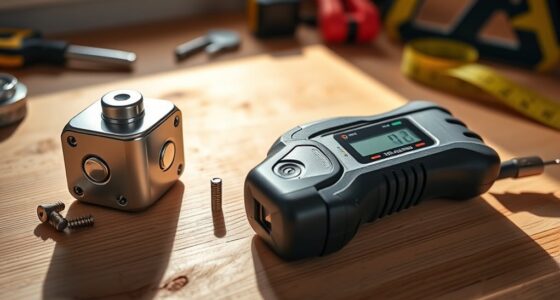To guarantee neighborhood safety, stay aware of crime patterns by monitoring local reports and environmental factors like lighting and vegetation. Secure your home with sturdy locks, proper outdoor lighting, and visible security systems. Build strong community ties by participating in neighborhood watch programs and staying vigilant of your surroundings. Use technology like cameras and emergency apps to enhance security. Keep practicing these steps daily, and you’ll discover even more ways to create a safer, more connected neighborhood.
Key Takeaways
- Monitor crime patterns and environmental factors like lighting and vegetation to identify safety concerns.
- Secure home entry points and improve outdoor lighting to deter intruders.
- Foster neighbor relationships through communication and community activities for collective vigilance.
- Join neighborhood watch programs and stay alert during walks, avoiding distractions and suspicious behavior.
- Use technology such as security cameras and emergency apps for real-time safety monitoring and quick response.
Understanding Local Crime Trends

Have you ever wondered how to get a clear picture of crime in your neighborhood? Understanding local crime trends starts with analyzing crime patterns over time. Police reports are your best resource—they detail the types of crimes, times, and locations where incidents occur most often. By reviewing these reports regularly, you can spot recurring issues or spikes in certain crimes. Recognizing these patterns helps you identify when and where your neighborhood might need extra vigilance. Keep track of changes in crime activity, and note any shifts in the types of incidents reported. This proactive approach empowers you to stay informed and ready, so you can better assess risks and support community efforts to improve safety. Additionally, being aware of water-related safety concerns can help prevent accidents near pools or lakes in your area.
Securing Your Home and Property
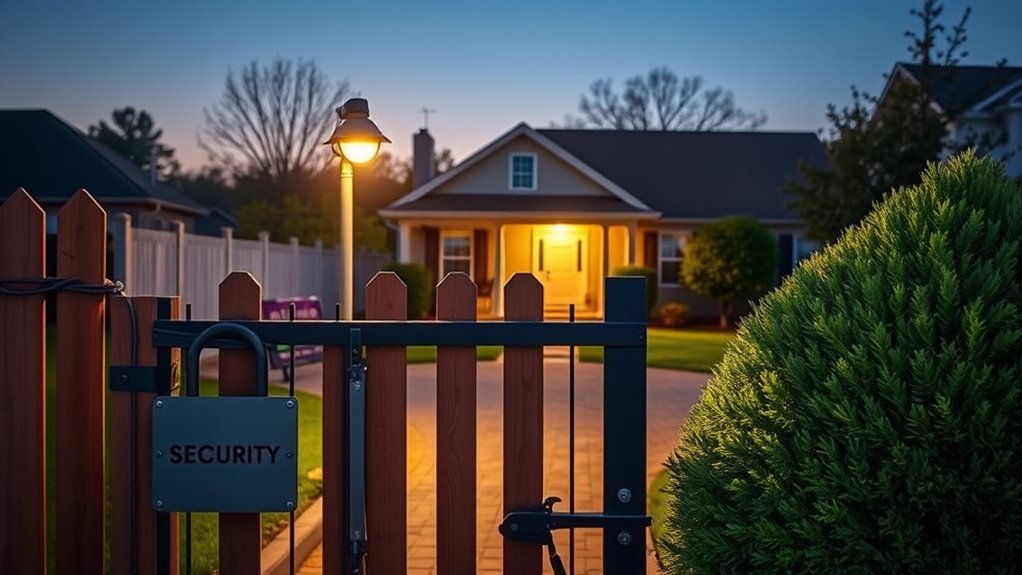
To better protect your home, start by reinforcing your entry points like doors and windows to make them harder to break through. Proper lighting around your property can also deter intruders by eliminating dark hiding spots. Taking these steps helps create a safer environment for you and your neighbors. Additionally, installing security systems can provide an extra layer of protection and peace of mind.
Reinforce Entry Points
Securing your home begins with reinforcing all entry points to prevent unauthorized access. Start with door reinforcement by installing sturdy strike plates, deadbolts, and security bars if needed. Reinforcing doors makes it harder for intruders to force their way in. Don’t forget about window security; add shatter-resistant film, locks, or security bars to windows, especially those easily accessible from the ground. Check that all entry points fit snugly and are in good condition. Reinforcing these areas markedly reduces the risk of break-ins. Keep in mind, simple upgrades like adding a peephole or smart lock can enhance security without extensive effort. Additionally, considering security measures such as motion-activated lighting can further deter intruders. Taking these steps ensures your home is a less attractive target for burglars.
Maintain Proper Lighting
Proper lighting is essential for deterring intruders and increasing visibility around your property. Well-placed outdoor security lights make it harder for burglars to approach unnoticed. Strategic lighting illuminates dark corners and entry points, creating a safer environment. When you install outdoor security lighting, consider motion-activated floods near driveways and pathways. Use solar-powered lights along walkways to save energy and ensure consistent illumination. Place fixtures high enough to avoid tampering but low enough for effective coverage. Keep lights clean and functional, replacing bulbs as needed. Good lighting not only discourages unwanted visitors but also helps neighbors and emergency responders see clearly. Properly maintained, strategic lighting creates a safe, welcoming atmosphere around your home and property.
Effective Lighting and Visibility

Good lighting makes your neighborhood safer by deterring potential intruders. You should verify streetlights are working properly, trim overgrown vegetation that blocks visibility, and install motion sensors to light up dark areas. These simple steps can greatly improve safety and help you feel more secure at night. Regularly inspecting and maintaining lighting performance metrics can ensure that your lighting system remains effective over time.
Proper Street Lighting
Effective street lighting plays a crucial role in enhancing neighborhood safety by improving visibility for pedestrians and drivers alike. Proper street illumination ensures that pathways, intersections, and crosswalks are well-lit, reducing accidents and criminal activity. Using high-quality lighting fixtures, you can create a safer environment that discourages lurking and promotes awareness. Imagine walking along a street where the glow from evenly spaced lighting fixtures casts a clear path ahead, revealing potential obstacles and suspicious figures. Bright, consistent lighting covers adequate brightness levels that eliminate dark spots, making it easier to identify hazards and individuals. Regular maintenance to keep lights functional and effective is essential for sustained safety.
Trim Overgrown Vegetation
Overgrown vegetation can substantially hinder visibility even in well-lit neighborhoods. Regular landscape maintenance, including shrub trimming, keeps sightlines clear and minimizes hiding spots for potential intruders. Overgrown bushes and trees near walkways, driveways, and entry points should be pruned to prevent obstruction of streetlights and security cameras. When shrubs grow too tall or dense, they create dark corners that reduce overall safety. By trimming overgrowth, you improve visibility for neighbors and passersby, making it easier to spot suspicious activity. Consistent landscape maintenance also enhances curb appeal and discourages trespassers. Additionally, electric dirt bikes are gaining popularity as quiet and eco-friendly transportation options that can be used for neighborhood patrols or quick errands. Remember, well-maintained vegetation isn’t just about aesthetics; it’s a simple yet effective way to boost neighborhood safety and create a more welcoming environment.
Install Motion Sensors
Installing motion sensors is a practical way to enhance neighborhood safety by guaranteeing your outdoor lighting responds to activity. Proper sensor placement is key to maximizing their effectiveness. Position sensors at entry points, along pathways, and near dark corners where intruders might hide. Adjust the motion detection sensitivity to prevent false alarms from passing cars or animals. Use sensor coverage to illuminate large areas without leaving dark spots. Regularly test sensors to guarantee they activate correctly, and consider weatherproof options for durability. Good placement and proper calibration help deter intruders and increase visibility for you and neighbors. Additionally, understanding that attention plays a crucial role in creative practice emphasizes the importance of focus and mindfulness in setting up effective security measures. By strategically installing motion sensors, you create a safer environment that reacts instantly to movement, making your neighborhood less inviting to potential threats.
Building Strong Community Relationships
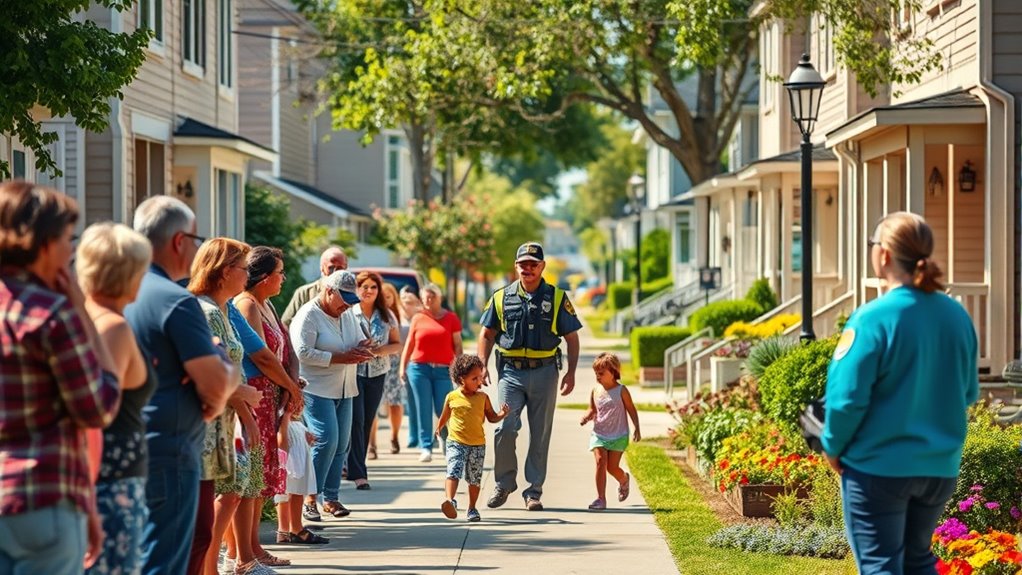
How can neighbors come together to create a safer, more connected community? The key is building strong relationships through regular neighbor communication. Attend community events like block parties or neighborhood cleanups to meet others and foster trust. These gatherings give you opportunities to share safety tips, discuss concerns, and learn about each other’s routines. When neighbors know and trust one another, they’re more likely to look out for each other and respond quickly to issues. Establishing open lines of communication helps create a sense of unity and shared responsibility. Remember, a tight-knit community isn’t just about socializing—it’s about creating an environment where everyone feels invested in safety and well-being. Strong relationships lay the foundation for a safer, more resilient neighborhood. Additionally, implementing security system options can significantly enhance neighborhood safety by providing reliable surveillance and alerts.
Staying Alert and Mindful of Your Surroundings
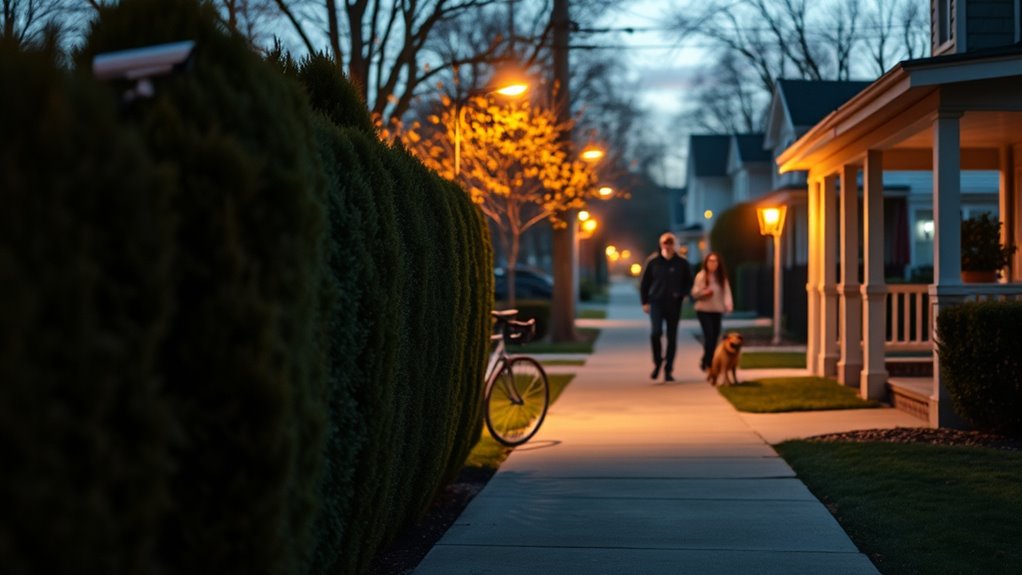
Being aware of your surroundings is essential for maintaining neighborhood safety. Practicing good situational awareness helps you spot potential threats early and respond appropriately. To stay alert, avoid distraction by keeping your phone down and focusing on your environment. Pay attention to unusual behavior or unfamiliar vehicles nearby. Notice the details: someone loitering in a quiet alley, a package left unattended on a porch, or a stranger asking unusual questions. Trust your instincts—if something feels off, take action. Keep your head up and scan your surroundings regularly. Remember, distraction avoidance keeps you vigilant and ready to react. Staying mindful of your environment not only protects you but also contributes to a safer neighborhood for everyone. Being familiar with local safety tips can further enhance your awareness and preparedness.
Utilizing Neighborhood Watch Programs

Participating in your neighborhood watch program is a proactive way to enhance safety and foster community cooperation. By joining, you can help organize neighborhood patrols that keep an eye out for suspicious activity and deter potential crime. Regular patrols create a visible presence that reassures residents and discourages wrongdoers. Effective community communication is essential; sharing updates, concerns, and tips keeps everyone informed and prepared. Attend meetings to stay connected with neighbors and law enforcement, and use neighborhood apps or social media to exchange real-time information. Your involvement strengthens the network, making your neighborhood a safer place. Active participation not only reduces crime but also builds trust and a sense of shared responsibility among residents. Incorporating community engagement strategies can further improve neighborhood safety and cohesion.
Safe Practices for Moving Around the Neighborhood
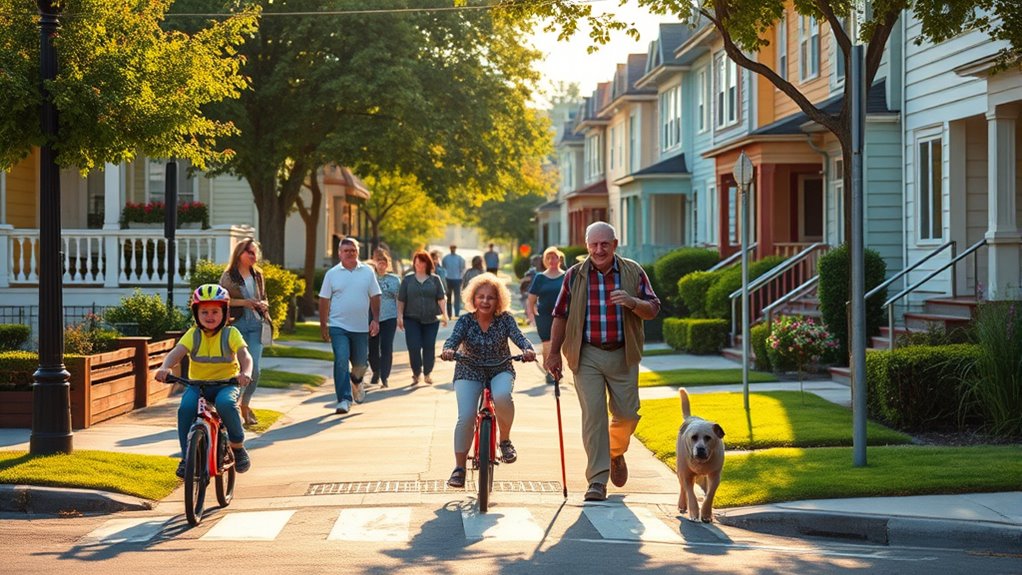
Joining a neighborhood watch program not only helps prevent crime but also encourages residents to stay vigilant about their surroundings. When moving around your neighborhood, prioritize personal safety by staying alert and aware of your environment. Be mindful of unfamiliar faces or activities, and trust your instincts if something feels off. Keep your phone accessible in case of emergencies, and walk confidently to deter potential threats. Incorporating expert voice actors into community safety campaigns can further enhance awareness and engagement among residents.
- Stick to well-lit paths and avoid shortcuts through hidden areas
- Walk with a friend or in groups when possible
- Keep valuables out of sight and secure your home before heading out
- Make eye contact and stay aware of your surroundings to maintain neighborhood awareness
Practicing these safe habits helps protect you and fosters a secure neighborhood for everyone.
Leveraging Technology for Safety

Utilizing modern technology can substantially enhance your safety in the neighborhood. Smart security systems, like cameras and motion sensors, allow you to monitor your property remotely and receive real-time alerts about suspicious activity. These tools act as a deterrent for potential intruders and give you peace of mind. Emergency apps are another valuable resource; they enable you to quickly contact authorities or trusted contacts during a crisis with just a tap. Some apps even include location sharing features, so loved ones know your whereabouts. By integrating smart security and emergency apps into your safety routine, you stay connected and proactive. Leveraging these technologies helps you respond faster to threats and creates a safer environment for everyone in your neighborhood.
Encouraging a Culture of Care and Vigilance

Building on the use of technology to enhance safety, fostering a culture of care and vigilance among neighbors creates a stronger, more resilient community. When you prioritize community engagement and neighbor communication, everyone feels more connected and aware of potential issues. This shared responsibility encourages proactive action and trust. Establishing clear communication channels can help in active listening and empathy, ensuring concerns are addressed promptly and effectively. Consider organizing neighborhood watch groups or casual meet-ups to strengthen bonds. Use messaging apps or social media to share updates quickly. Recognize and support neighbors who look out for each other. Promote open dialogue about safety concerns and solutions.
Frequently Asked Questions
How Can I Teach Children Safety Awareness in My Neighborhood?
You can teach children safety awareness by involving them in neighborhood activities and discussing child safety rules regularly. Encourage them to stay within sight, avoid talking to strangers, and identify safe places like neighbors’ homes. Use fun lessons or role-playing to reinforce neighborhood awareness, making safety a daily habit. By actively engaging kids and setting clear boundaries, you help build their confidence and ensure they understand how to stay safe.
What Should I Do if I Witness Suspicious Activity?
Think of suspicious activity as a flickering lighthouse warning you of danger. When you see it, don’t hesitate—trust your instincts. Call your community patrol or emergency contacts right away, like sounding the alarm to rally help. Stay on the line with authorities until they arrive, and keep a safe distance. Your quick action can prevent trouble and keep your neighborhood safe, shining a light on safety for everyone.
How Can I Involve Seniors in Neighborhood Safety Efforts?
You can involve seniors in neighborhood safety efforts through senior engagement and elderly outreach programs. Invite them to community meetings, patrols, or safety workshops to make them feel valued and informed. Encourage them to share their concerns and experiences, fostering trust and collaboration. By actively including seniors, you harness their wisdom and vigilance, strengthening overall neighborhood safety and ensuring they feel connected and protected.
Are There Specific Safety Tips for Outdoor Activities and Events?
When participating in outdoor activities and events, always stay aware of your surroundings and plan ahead. Use well-lit areas and encourage your community to improve community lighting, which helps deter crime. Carry a charged cell phone for emergency preparedness, and share your plans with someone you trust. Stay in groups when possible, and avoid isolated spots. Being vigilant and prepared guarantees you enjoy outdoor events safely and responsibly.
How Can I Address Safety Concerns With Local Authorities Effectively?
Your safety concerns are as crucial as the air you breathe. To address them effectively, start by joining a community patrol or neighborhood watch to demonstrate your commitment. Clearly communicate specific issues to local authorities, providing details and evidence. Attend community meetings, voice your concerns confidently, and collaborate with neighbors. This proactive approach builds trust and ensures your safety concerns are prioritized, making your neighborhood a safer, more united place.
Conclusion
Remember, as the saying goes, “It takes a village,” and your active participation makes your neighborhood stronger. By staying informed, vigilant, and fostering community bonds, you create a safe haven reminiscent of the watchful eyes of ancient guardians. Your awareness and care are the shields that protect your home and neighbors alike. Embrace these practices, and together, you’ll build a resilient neighborhood that stands firm against any threat, just like a well-guarded fortress.





